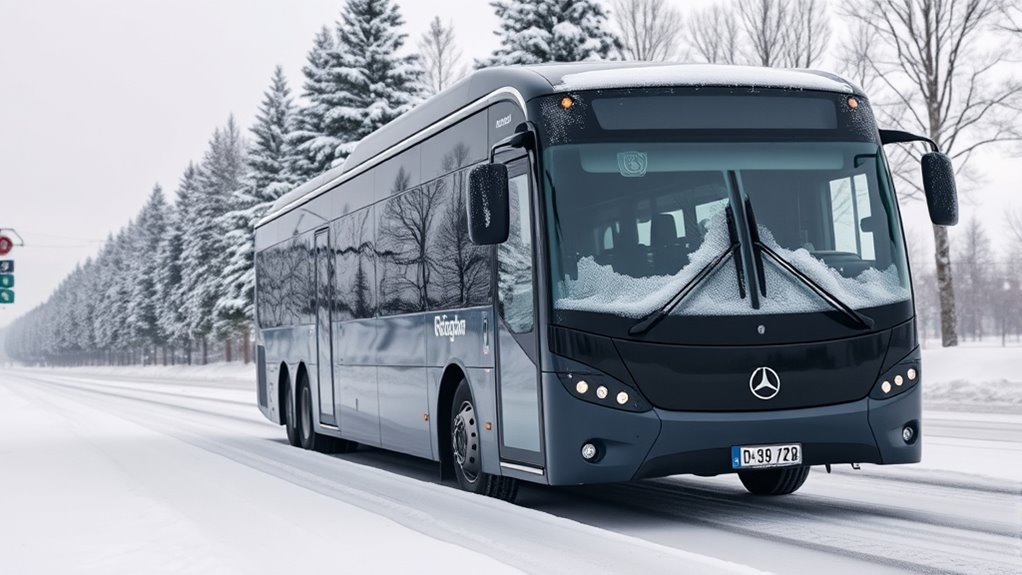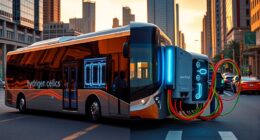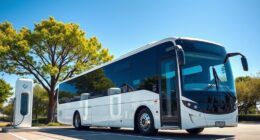In Finland, operating electric buses in sub-zero temperatures demands advanced thermal management systems that keep batteries warm and guarantee passenger comfort. You’ll find that active heating, insulation, and heat recovery are key to maintaining battery performance and preventing freezing. These systems reduce service disruptions and boost reliability, even below -20°C. By combining thermal solutions with efficient climate control, Finland sets a strong example for cold-weather electric transit. Keep exploring to discover how these innovations make winter operations seamless.
Key Takeaways
- Finland’s advanced thermal management ensures electric buses operate reliably in sub-zero temperatures.
- Active heating and insulation prevent battery freezing, maintaining performance during winter.
- Efficient climate control systems keep passenger cabins warm even below -20°C.
- Proper thermal solutions reduce battery degradation, increasing vehicle lifespan and reducing service disruptions.
- Integrated thermal and climate systems enhance ride comfort and operational reliability in cold climates.

Finland is leading the way in electric bus adoption, transforming its public transportation system to be cleaner and more sustainable. But operating these buses in sub-zero temperatures presents unique challenges that require innovative solutions. One of the most critical aspects is battery thermal management. Cold weather can severely impact battery performance, reducing range and efficiency. To overcome this, Finnish operators invest heavily in sophisticated thermal management systems that keep batteries within ideal temperature ranges. These systems use active heating elements and insulation to prevent battery freezing, ensuring the buses maintain their range and reliability even during the coldest months. Proper thermal management not only preserves battery health but also minimizes downtime, allowing you to rely on electric buses year-round without frequent service interruptions. Additionally, the use of advanced insulation materials helps to further protect the vehicle components from extreme cold, enhancing overall durability and safety. Passenger comfort is another significant consideration in Finland‘s cold climate. Electric buses often feature advanced climate control systems that work in tandem with their thermal management technologies. As a passenger, you benefit from warm, cozy interiors, even when outdoor temperatures plummet below -20°C. These systems quickly and efficiently heat the cabin without draining the battery excessively, thanks to intelligent energy management and heat recovery techniques. This means you can enjoy a comfortable ride without concern for the bus’s range or the engine’s performance. Finnish transit authorities also prioritize smooth acceleration and deceleration, which enhances the ride quality and reduces vibrations that can be uncomfortable in colder weather. The seamless integration of passenger comfort features with thermal management ensures a pleasant, reliable experience during harsh winter months.
Frequently Asked Questions
How Do Electric Buses Handle Snow and Ice on Roads?
You’ll find that electric buses handle snow and ice well, thanks to specialized snow traction tires and anti-slip systems. Ice detection sensors alert you to icy patches, allowing for cautious driving. Regenerative braking also helps maintain control on slippery surfaces. Overall, these features work together to guarantee safe operation, even in harsh winter conditions, giving you confidence on snow-covered and icy roads.
What Is the Impact of Cold Weather on Battery Life?
Sure, cold weather totally loves extending your battery life—sarcasm intended. You’ll find that battery degradation speeds up in freezing temps, making your electric bus less reliable. That’s why thermal management becomes your best friend, keeping batteries warm and healthy. Without proper thermal control, expect reduced range and increased wear. So, in sub-zero conditions, cold actually hits your battery’s lifespan hard, forcing you to plan for more frequent charging.
Are There Special Maintenance Procedures for Winter Conditions?
Yes, you should perform winter-specific diagnostics regularly to identify potential issues early. Use frost prevention techniques like insulating battery packs and applying heaters to guarantee ideal performance. Check the electrical connections and cooling systems frequently, especially before cold spells, to prevent freezing and maintain efficiency. Implementing these maintenance procedures helps keep your electric buses reliable and safe during harsh winter conditions.
How Do Passengers Stay Warm During Long Winter Routes?
Like a cozy cabin in winter’s grip, your electric bus keeps passengers warm with seat heating and insulated cabins. You stay comfortable during long routes by relying on these features, which trap heat and prevent cold drafts. The seat heaters provide direct warmth, while the insulated cabins maintain a steady internal temperature. This combination guarantees a warm, welcoming ride even in the harshest sub-zero conditions.
What Are the Costs of Operating Electric Buses in Sub-Zero Temperatures?
The costs of operating electric buses in sub-zero temperatures are higher due to increased energy consumption for heating and battery management. You’ll see a cost comparison showing elevated energy expenses compared to milder conditions, but these are offset by lower maintenance costs. You’ll need to budget for additional energy use, but the overall savings from electric buses, like reduced fuel costs, still make them a viable option despite the colder climate.
Conclusion
As you navigate Finland’s icy roads, you realize that operating electric buses in sub-zero temperatures isn’t just about technology—it’s about resilience and innovation. But as winter deepens, questions linger: Will the batteries hold up in even harsher conditions? Can the system adapt fast enough to keep passengers safe and comfortable? The journey isn’t over yet. The true test begins when the coldest days arrive, and only time will reveal if these solutions can withstand nature’s fiercest challenges.









